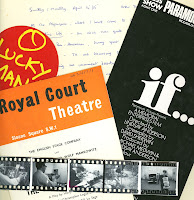The Cinema Authorship of Lindsay Anderson is a three-year research project at the University of Stirling, funded by the Arts and Humanities Research Council (AHRC). There are four of us in the research team. Myself (Research Assistant), John Izod (Principal Investigator) Karl Magee (Co-investigator and University Archivist) and Isabelle Gourdin (Doctoral Candidate). The project will use Lindsay Anderson's personal and working papers together with previously published material, to examine the director's claim to the status of authorship by investigating the connection between his films and his personality. This will be done by comparing his private thoughts, expressed in his diaries, correspondence and other personal papers, with his public statements about his films, the film industry in general, and the ways in which films are received, found in his articles, interviews, books and letters to the press. Both the public and the private aspects of Anderson's claims to authorship will be examined in the wider context of the ways in which his ideas were received, interpreted and disseminated by the various publics to which they were addressed.
Lindsay Anderson is a central figure in the history of British cinema in the twentieth century. There are his well-known and critically acclaimed films of the 1960s and 1970s including
This Sporting Life, starring Richard Harris and
If.... starring Malcolm McDowell. Anderson was also one of the founders of the '
Free Cinema' movement in the 1950s which challenged the established conservatism of British cinema with documentaries (and some dramas) reflecting the everyday lives of ordinary people. In addition he was a respected writer and film critic and one of the founders of the influential film journal
Sequence in 1947. As well as his important to the history of British cinema he was also a highly respected theatre director. He worked with many of the most well-known and central figures of the British stage. Lindsay Anderson died in 1994, aged 71. There is a complete list (to file level), composed by the University Archivist Karl Magee, which details all of Lindsay Anderson's film/stage/television work and critical writings.
The main focus of my part in this project is to catalogue the collection to item level so that the material can be easily accessed and used for research. The project is now halfway through so I feel I know the Collection quite well now, though there are still lots of surprises (one of the joys of working with archive material) like the other day when I came across a letter from Lindsay Anderson to his friend, the writer Gavin Lambert, where he informs Lambert that he has had to turn down a part in 'Return of the Jedi' because he was too busy with his own work!

© Lindsay Anderson Collection,
University of Stirling
The Lindsay Anderson Collection contains a huge variety of types of records: letters; diaries; notebooks from the sets of films; production notes; on-set photographs for both film and theatre work; personal photograph albums; Anderson's large book library (with annotations by him in some of the books); his personal VHS library with its own card catalogue system; music cassettes; recordings of Anderson transcribing letters; press cuttings (reviews of his work and press cuttings that he used for inspiration for his work); family memorabilia; and many of the paintings and prints that hung on the walls of his home. I'm sure I will still have missed some out but you get the picture! It is a really interesting collection to work with, though I know most archivists think that of the collections they work with - again I think this is one of the joys of the job, getting to work with such a variety of records and realising the potential and interest in all these records. The Collection contains material on Anderson's theatre and film work but as the research project is 'The Cinema Authorship of Lindsay Anderson' my priority is to catalogue all the parts of the collection relating to his film work. This distinction is not always so clear cut, for example, in a letter to a theatre critic Anderson might also discuss the reception of his latest film. However as the Collection is divided up primarily by film/play/television production/book this makes my job slightly easier and gave me a starting point. In future posts I'll talk more about the arrangement of the Collection and highlight some of the interesting records I've come across but for now I'll stop as I just wanted to give an introduction and a broad picture of the Archive I'm working with.


No comments:
Post a Comment